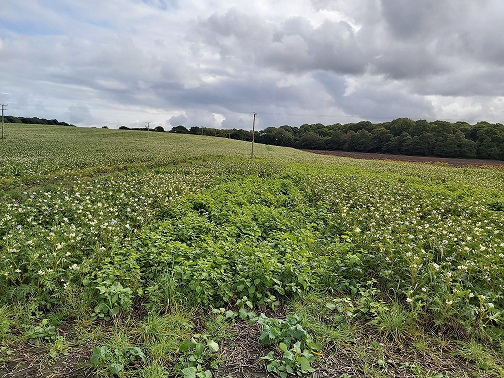Please click here to access the main AHDB website and other sectors.
- Home
- Knowledge library
- Trap crops for the management of potato cyst nematodes
Trap crops for the management of potato cyst nematodes
Trap crops stimulate PCN to hatch but are ultimately unsuitable hosts for the pests. The nematodes fail to multiply resulting in a reduction in their numbers
The most widely studied PCN trap crop is Solanum sisymbriifolium (sticky nightshade). It has the potential to reduce PCN population densities by 75-80%, but the ideal establishment time is May/June and the crop has a track record of being difficult to establish in GB.
Another plant, Solanum scabrum (African nightshade) is a potential trap crop which appears to be easier for growers to establish, but currently lacks clear establishment guidelines for GB.
Trials were carried out in 2020 and 2021 to address the gaps in knowledge about establishment and herbicide use.
Two presentations explaining trap crops recorded in January 2021
Innovative Farmers Field Lab 2020-21
Drilling date and depth
Four group members of the Shropshire Potato Growers Discussion Group hosted trials in 2020. The aim was to develop good establishment practice for both S. sisymbriifolium and S. scabrum when drilled after cereal harvest. Key aspects were date of drilling and drilling depth.
The treatments were:
- Two planting dates: (late) early July and (very late) early August
- Two planting depths: 1cm and 3cm
Measurements included emergence counts on several dates to monitor first and final emergence speed and percentage; ground cover and PCN counts pre trap crop (Pi) and after trap crop destruction (Pf).
Seedbed nitrogen
In 2021, trials investigated if seedbed nitrogen would improve trap crop establishment and the subsequent impact on PCN populations
Weed control in Solanum trap crops 2021
In 2021, AHDB funded a trial to determine if there are herbicides which would be safe and effective to use in trap crops. The treatments were hand-hoed (to simulate inter-row cultivation) and different pre- or post-emergence herbicides as well as an untreated control.
- Weed cover was the lowest in the plots receiving pre-em pethoxamid and post-em bentazone
- Post-em bentazone had statistically higher phytotoxicity scores in September than all other treatments
 AHDB
AHDB
S. scabrum and S. sisymbriifolium plots drilled 29 June 2020
Video recorded September 2020

